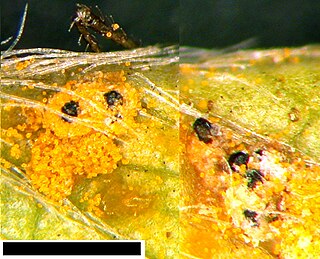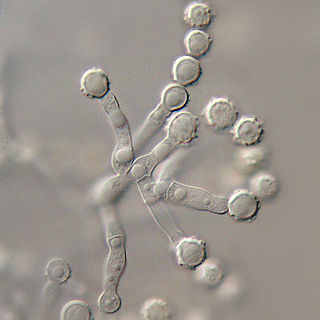Spegazzinia is a genus of widely distributed mitosporic ascomycete fungi in the family Didymosphaeriaceae.As accepted by Wijayawardene et al. 2020.

The Nectriaceae comprise a family of fungi in the order Hypocreales. It was circumscribed by brothers Charles and Louis René Tulasne in 1865. In 2020, an Outline of fungi was produced and listed 70 genera and about 1,336 species.

The Mycosphaerellaceae are a family of sac fungi. They affect many common plants, such as eucalyptus, the myrtle family, and the Proteaceae. They have a widespread distribution.

The Botryosphaeriaceae are a family of sac fungi (Ascomycetes), which is the type representative of the order Botryosphaeriales. According to a 2008 estimate, the family contains 26 genera and over 1500 species. Members of this order include notable plant pathogens.

Phyllachoraceae is a family of sac fungi.
The Melanommataceae are a family of fungi in the order Pleosporales. Taxa are widespread in temperate and subtropical regions, and are saprobic on wood and bark.
The Roussoellaceae are a family of fungi in the order Pleosporales. As accepted by Wijayawardene et al. 2020;

The Phaeosphaeriaceae are a family of fungi in the order Pleosporales. Species in the family have a cosmopolitan distribution, and are generally nectrotrophic or saprobic on a wide range of plants.
The Didymosphaeriaceae are a family of fungi in the order Pleosporales. The family was erected by Anders Munk in 1953.

The Dactylosporaceae or Sclerococcaceae are a family of lichen-forming fungi in the class Eurotiomycetes. It is the only family of the order Sclerococcales and subclass Sclerococcomycetidae.

The Stictidaceae are a family of fungi in the order Ostropales. The family was first described by Swedish mycologist Elias Magnus Fries in 1849.

The Microascaceae are a family of fungi in the class Sordariomycetes, subclass Hypocreomycetidae. The family was published by David Malloch in 1970, an emended description based on Everet Stanley Luttrell's original 1951 publication. Family was updated in 2020.
Montagnula is a genus of fungi in the family Didymosphaeriaceae. The genus, circumscribed by mycologist Augusto Napoleone Berlese in 1896, contains an estimated 24 species in 2008, but is probably polyphyletic as currently circumscribed. It was originally placed in family Montagnulaceae, before that family was dissolved and it was later placed in family Didymosphaeriaceae, with 34 species.
Bertiella is a genus of fungi in the family Teichosporaceae. although Wijayawardene et al. 2020 places it within the Melanommataceae family.

Herpotrichiellaceae is a family of ascomycetous fungi within the order Chaetothyriales and within the class Eurotiomycetes. It contains 16 genera and about 270 species. The type genus of the family, Herpotrichiella, is now synonymous with Capronia.
Broomella is a genus of fungi in the family Sporocadaceae.
Semifissispora is a genus of fungi in the class Dothideomycetes. It was placed in Massarinaceae family and was accepted by Wijayawardene et al. 2020;
The Niessliaceae are a family of fungi in the Ascomycota phylum, class Sordariomycetes. The family was updated in 2020.
Phragmocapnias is a genus of fungi in the family Capnodiaceae.

The Leptosphaeriaceae are a family of fungi in the order Pleosporales. The family was circumscribed by mycologist Margaret E. Barr in 1987. According to the Dictionary of the Fungi, the family contained 8 genera and 302 species. The family has a widespread distribution, but is especially prevalent in temperate regions. Species are either saprobic or grow as nectrotrophs on the stems or leaves of plants.










